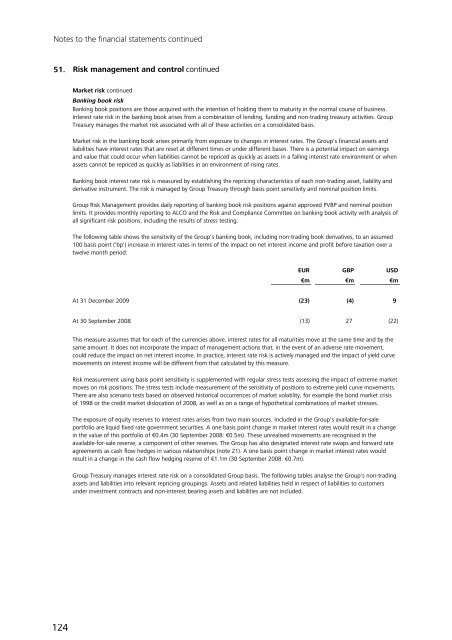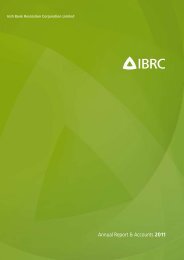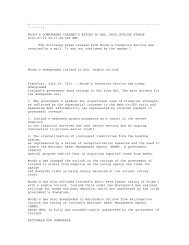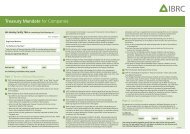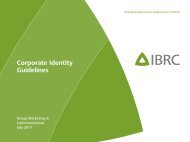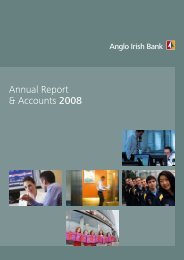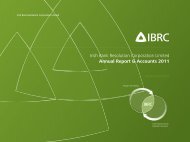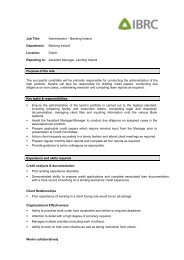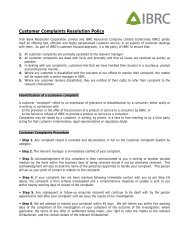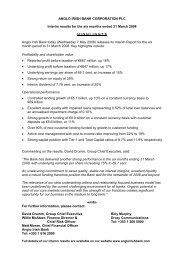Annual Report & Accounts 2009 - Anglo Irish Bank
Annual Report & Accounts 2009 - Anglo Irish Bank
Annual Report & Accounts 2009 - Anglo Irish Bank
Create successful ePaper yourself
Turn your PDF publications into a flip-book with our unique Google optimized e-Paper software.
Notes to the financial statements continued<br />
51. Risk management and control continued<br />
124<br />
Market risk continued<br />
<strong>Bank</strong>ing book risk<br />
<strong>Bank</strong>ing book positions are those acquired with the intention of holding them to maturity in the normal course of business.<br />
Interest rate risk in the banking book arises from a combination of lending, funding and non-trading treasury activities. Group<br />
Treasury manages the market risk associated with all of these activities on a consolidated basis.<br />
Market risk in the banking book arises primarily from exposure to changes in interest rates. The Group's financial assets and<br />
liabilities have interest rates that are reset at different times or under different bases. There is a potential impact on earnings<br />
and value that could occur when liabilities cannot be repriced as quickly as assets in a falling interest rate environment or when<br />
assets cannot be repriced as quickly as liabilities in an environment of rising rates.<br />
<strong>Bank</strong>ing book interest rate risk is measured by establishing the repricing characteristics of each non-trading asset, liability and<br />
derivative instrument. The risk is managed by Group Treasury through basis point sensitivity and nominal position limits.<br />
Group Risk Management provides daily reporting of banking book risk positions against approved PVBP and nominal position<br />
limits. It provides monthly reporting to ALCO and the Risk and Compliance Committee on banking book activity with analysis of<br />
all significant risk positions, including the results of stress testing.<br />
The following table shows the sensitivity of the Group’s banking book, including non-trading book derivatives, to an assumed<br />
100 basis point ('bp') increase in interest rates in terms of the impact on net interest income and profit before taxation over a<br />
twelve month period:<br />
At 31 December <strong>2009</strong><br />
At 30 September 2008<br />
EUR GBP USD<br />
€m €m €m<br />
(23) (4) 9<br />
(13) 27 (22)<br />
This measure assumes that for each of the currencies above, interest rates for all maturities move at the same time and by the<br />
same amount. It does not incorporate the impact of management actions that, in the event of an adverse rate movement,<br />
could reduce the impact on net interest income. In practice, interest rate risk is actively managed and the impact of yield curve<br />
movements on interest income will be different from that calculated by this measure.<br />
Risk measurement using basis point sensitivity is supplemented with regular stress tests assessing the impact of extreme market<br />
moves on risk positions. The stress tests include measurement of the sensitivity of positions to extreme yield curve movements.<br />
There are also scenario tests based on observed historical occurrences of market volatility, for example the bond market crisis<br />
of 1998 or the credit market dislocation of 2008, as well as on a range of hypothetical combinations of market stresses.<br />
The exposure of equity reserves to interest rates arises from two main sources. Included in the Group's available-for-sale<br />
portfolio are liquid fixed rate government securities. A one basis point change in market interest rates would result in a change<br />
in the value of this portfolio of €0.4m (30 September 2008: €0.5m). These unrealised movements are recognised in the<br />
available-for-sale reserve, a component of other reserves. The Group has also designated interest rate swaps and forward rate<br />
agreements as cash flow hedges in various relationships (note 21). A one basis point change in market interest rates would<br />
result in a change in the cash flow hedging reserve of €1.1m (30 September 2008: €0.7m).<br />
Group Treasury manages interest rate risk on a consolidated Group basis. The following tables analyse the Group's non-trading<br />
assets and liabilities into relevant repricing groupings. Assets and related liabilities held in respect of liabilities to customers<br />
under investment contracts and non-interest bearing assets and liabilities are not included.


